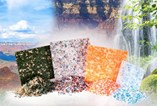Innovations In Plastic Acrylic Sheet Casting

By Dan Rustin, Acrilex
Satisfying the need for specialty materials in an age of supply constraints
As more plastic manufacturers are streamlining operations and shifting acrylic sheet casting to overseas production, it becomes very difficult to offer innovative specialty materials. Larger required material runs, longer lead times, expensive shipping costs – how do architects and designers using acrylic in architectural applications satisfy their desire for specialty materials under these circumstances? There are fewer and fewer opportunities left for innovation in the local marketplace because these supply issues have become a real stumbling block.
In the cell cast acrylic sheet market, larger manufacturers are simply not set up to do individualized, small volume custom projects that require mixing colors entirely by hand, rather than using large automated equipment. Many companies abound that can produce a large volume economy product, but those looking for innovative or customized approaches are finding it difficult to come by. There is a demand for specialty materials, but the demand is not consistent. Everything is project-specific – one customer may love a particular color, but that does not mean that other potential clients will want to use that same special color.
At the same time, the architect and designer (A&D) community has always been driven to create unique signature solutions that establish a brand identity unique to the product. Architects and designers working on such architectural applications as lighting, store fixtures, furniture, point-of-purchase displays, signage, and glazing want to create interesting looks, without using only the cheapest, standard stocked products. They are also looking to use more finishes to get a physical texture with a tactile or dimensional quality. The trend is to draw the consumer's eye with beautiful but subtle effects that give an added sense of luxury, value, and style.
Another design trend at play is the need for more environmentally friendly "green" products, using recycled materials, or satisfying building requirements found in the U.S. Green Building Council's Leadership in Energy and Environmental Design (LEED) certification program. The internationally recognized green building certification system verifies that a building uses materials that improve environmental performance.
In short, the A&D community needs companies that can create interesting looks using standard products, without requiring huge runs. To fill the gap between what major acrylic sheet manufacturers can supply quickly and cost effectively and what the A&D community is looking for, some U.S. companies are working on ways to produce stylish and innovative products efficiently and without long lead times. The need for a changed business model is a reasoned response to the urgent need to adapt or perish in the face of competitive pressures.
For example, Acrilex has spent the last decade adapting to these new realities by developing a much more efficient methodology for customization. The result is called Acriglas Combinations, in which one side of a standard clear sheet is colorized to create a custom-colored sheet. The process is not simple – there's still a distinct element of art to make the sheet uniform and free of inclusion.
Say a customer wants a ¾-inch thick piece of acrylic with a special color that meets its brand requirements. In the past, we would have cast the sheet in the color or gone to a supplier to obtain it. Since overseas suppliers now require custom products to be ordered in huge quantities, we have developed a way to add the customized color to the back of a stock sheet. The process offers one sheet color matched from inventory in a very short time with no minimum, a good way to get very small quantities of innovative products for an affordable price.
What has also changed is the ability to do this color mixing much more efficiently. Where once customization might have been achieve by mixing 7 colors, we now use 3 or 4 colors to achieve the same effect in the combination sheet.
Since Acrilex is a distributor, a final feature of the approach that also reduces costs to customers is the elimination of the additional markup from product distribution.
For example, for AT&T Wireless retail stores, Acrilex developed an Acriglas Combinations sheet for a cellular phone display shelf backdrop that would enhance the company's brand identity as well as co-branding with the distinct and recognizable look of Apple.
To develop the product, Acrilex started with a standard clear acrylic sheet with a matte finish on one side and then colorized and laminated a 1/8-inch sheet to it to produce a sheet with a total thickness of ½ inch. The sheet conceals the mechanical fasteners and security hardware to which the shelf is mounted, while giving the illusion of color and depth. Combining custom with stock material, the work used a custom cast sheet in the company's orange color, with a white clear Combinations sheet for the display shelves backdrop. The store fixture manufacture supplying AT&T just took the shelves and installed them. The project, which began with producing 10 sheets to test the concept, is now in place in all AT&T stores around the world.
Supply issues are indeed having a chilling effect all along the supply chain, from the A&D community, to fabricators, to distributors. The A&D community is faced with the prospect of sacrificing innovation because they cannot obtain specialty materials for other than enormous runs. Fabricators are finding it more difficult to meet customers' needs, and distributors are unable to obtain material that was formerly plentiful in the market.
What is the solution? Firms that can capitalize in the void in the market by developing alternatives that give customers custom-colored and textured specialty plastic materials at affordable prices are well placed to fill a real and growing need.
SOURCE:
